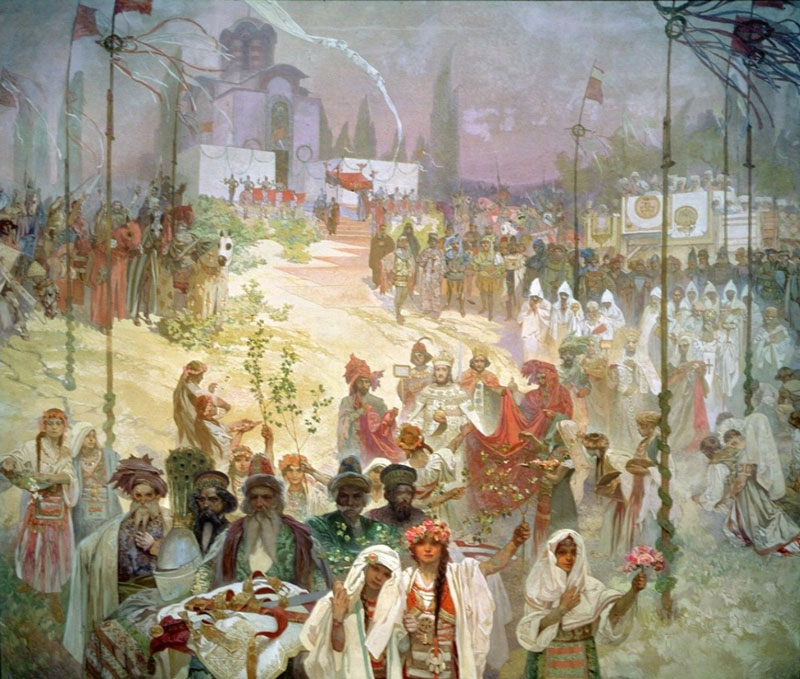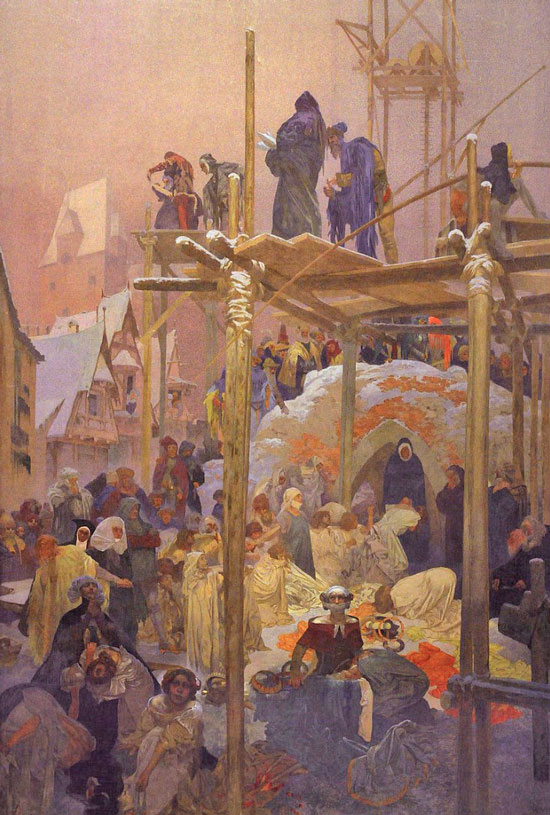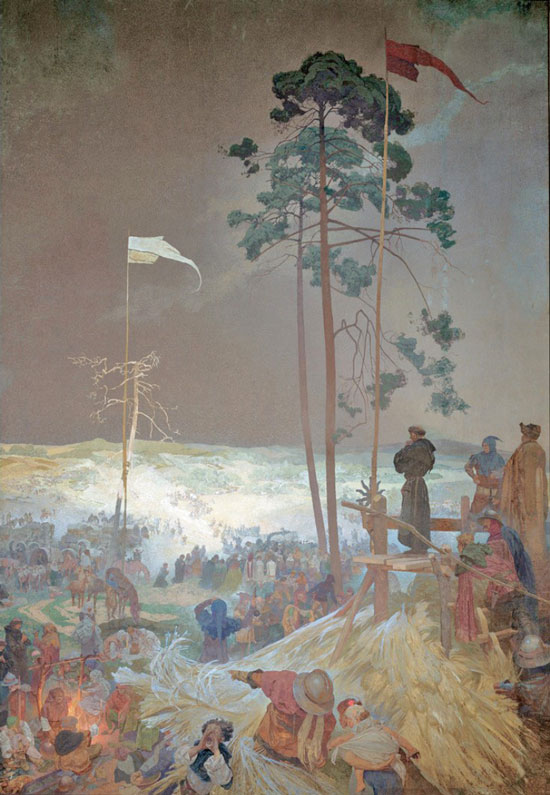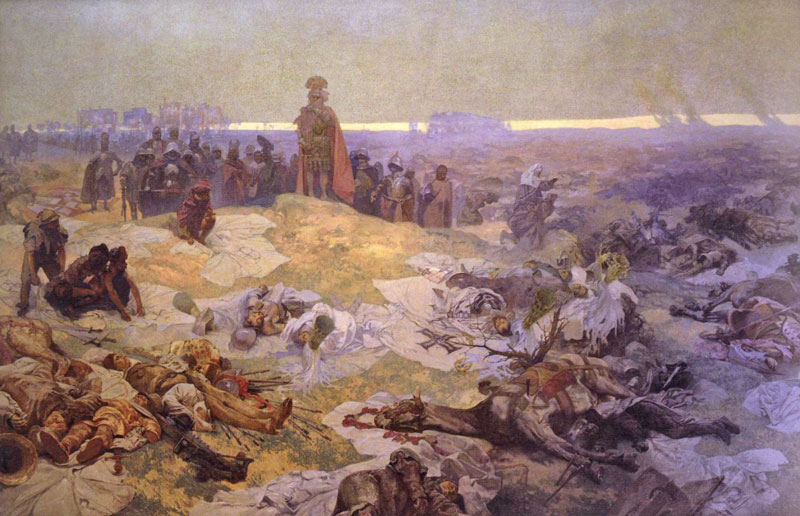Slav Epic Part Three – Paintings 6 to 10
This post explores the detail on the paintings numbered 6 to 10 in the Slav Epic series with interpretation, what to look for and historic context etc. If you want first to learn what leads up to the creation of the Slav Epic, who painted it, when and where it was painted, who owns it and where it is right now then check Slav Epic Part One.
Slav Epic Painting No.6: The Coronation of Serbian Tsar Štepán Dušan, Slavic Legislation (1926)

Tsar Štěpán Dušan was Serbian with his base in Skopje. During his lifetime in the 14th Century he created the Serbian Empire by conquering most of south-east Europe including all the current Balkan states plus Albania and Greece. Then he created 201 legal articles that became known as Dušan’s Code.
This along with other existing civil, criminal and church law, basically created the first common Slavic legal constitution. The painting is a celebration of the creation of recognised common law which would spread through international borders and be integrated into the Holy Roman Empire legal system. But Mucha does fit in a couple of his iconic features, the girls with braided hair and flowers around the head signifies Slavic traditions and other girls are holding Linden Tree branches wishing longevity to the Tsar and in general the Slavic race.
Slav Epic Painting No.7: Milíc of Kromeríž, Monastery of the Brothel (1916)

The painting is set in the late 14th Century, 1372 to be precise so it’s taking a look at the impact of the Catholic Church late in the reign of King Charles IV. This is foreshadowing the rise of the Hussites and people in general who are questioning how religion is being taught and practiced.
Later will come Jan Hus but in this painting Mucha concentrates on a character called Jan Milíč who was a theologian who basically resigned from his court role having witnessed the indulgences and corruption of the Church and built a monastery/convent/refuge on the site of a building in present-day Bartolomejska street in the Old Town which had been the site of a brothel. The building was then dedicated to Mary Magdalene. Jan Milíč is seen in the painting seated centre-far-right preaching to the women dressed in white who are former prostitutes that have chosen to discard their jewellery and bright clothes for a life of service to the community. The painting is all about Slavic compassion.
Slav Epic Painting No.8: Master Jan Hus Preaching at the Bethlehem Chapel: The Magic of the Word, Truth Prevails (1916)

Where Jan Milíč was trying to do good in small scale, Jan Hus was out to change the system and was the icon of attempts to reform the Catholic Church. The subtitle of the painting “Truth Prevails” is an extension of the Reformist belief that religion should be practiced by repeating the words of God i.e. the bible in the language of the masses.
The painting is supposed to be set in 1412 which would have been the year he had to leave Prague. There are a few things to look for. Primarily you see Jan Hus centre-left preaching to fellow reformers but above and to his right is a picture on the wall which depicts Jan Žižka, a future Hussite general. To Jan Hus’s left towards the centre is a man who is finely clothed. This is Wenceslas Kriz who donated the land and money for building Bethlehem Chapel where the picture is set. Look centre-right in the picture to a golden awning over a woman wearing a crown. This is supposed to be Queen Sophia (wife of King Wenceslas IV) supporting Jan Hus. I have two problems with this part, firstly if this is 1412 then Jan Hus has already been banned from preaching in Catholic churches and hence records show that Queen Sophia renounced any support for him. Secondly even if it was before 1410 as Queen to the Catholic Holy Roman Emperor any visit would have been clandestine so there’s a bit of artistic licence here. Also to note that Bethlehem Chapel does not get this “late-Gothic” appearance until the mid-16th Century.
The main character in the painting is not Jan Hus. If you look at the centre of the painting there is a woman wearing brightly lit white clothing who has a girl on her right and a boy on her left. They face neither Jan Hus nor the Queen and are clearly separated from the larger painting. This again is the choice of war or peace in the coming years.
Slav Epic Painting No.9: The Meeting at Krížky, the Magic of the word, Podoboji (1916)

In the Slav Epic there is now a section of five paintings concerning the Hussite Wars. This painting is no longer about the choice of war or peace. War is coming hence the “Podoboji” in the title which would translate as “preparation for fighting” and the beginning of armed conflict. The dark black clouds foretell bloodshed and the flags indicate a life or death struggle.
The man who replaces Jan Hus as leader of the reformists is Vaclav Korander, seen as the priest standing on the dais on September 30th 1419, rallying the arriving persecuted Hussites. The present-day “Krížky” is just some fields but it contains three crosses that mark this event. The Czech word for a cross is “kríž”.
Slav Epic Painting No.10: After the Battle of Grunewald, North Slavic Reciprocity (1924)

This painting is both about the sacrifice needed to achieve freedom but also the brotherhood of ideals. Around the same time as the previous two pictures we have the Teutonic Knights (German Catholic Military Order) trying to spread their Catholic religion and German language east through present day Czech, Poland, and Lithuania known as the Northern Slavic Countries as opposed to the Balkans which were considered the Southern Slavic Countries.
The Northern Slavs reach an agreement (Poland and Lithuania signed a full treaty to support each other in war like a kind of early NATO article 5). In 1410 this resulted in the Battle of Grunewald in Poland where the Slavs were victorious. The Battle of Grunewald included soldiers from Bohemia, Belarus, Ukraine and Russia but by far the most numerous forces were Polish and Lithuanian. In the painting the Polish King is surveying the battlefield and to either side of him are his commanders.
In another piece of artistic licence, Mucha includes Jan Žižka (the one with the eye patch) as one of the commanders despite historically being never proved if he was even in that battle. On the ground are the corpses of what remained of the Teutonic Knights commanders pulled from their horses by infantry. The blue cross was the symbol of the Teutonic Knights. So ultimately the painting celebrates Reciprocity or the inter-reliance of the Slavic countries to be able to defend themselves for common good.
Previous: Slav Epic Paintings 1 to 5
Next: Slav Epic Paintings 11 to 15